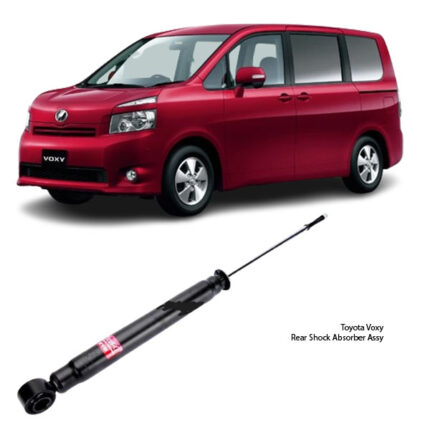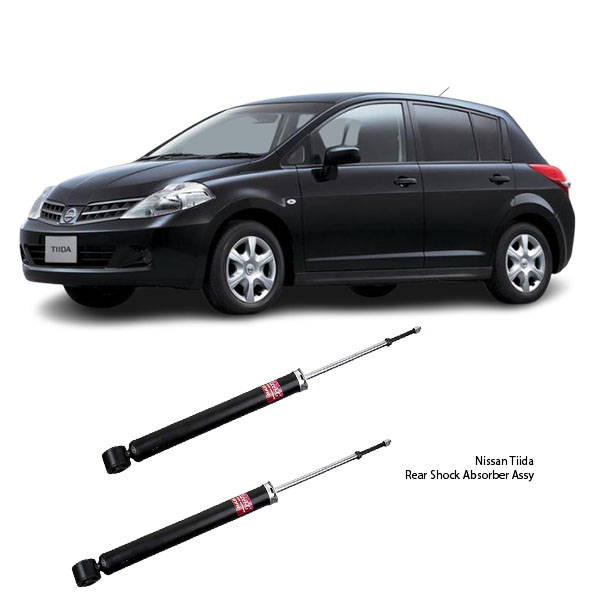Get Nissan Tiida Rear Shock Absorber Assy 343465 in Kenya
The Rear Shock Absorber Assembly is a key component of a vehicle’s suspension system, designed to manage and control the up-and-down motion of the rear wheels. While it works silently in the background, its role in ensuring comfort, control, and safety on the road cannot be overstated. Whether driving over potholes, uneven terrain, or braking under heavy load, rear shock absorbers are constantly at work, maintaining stability and absorbing road impacts.
What Is a Rear Shock Absorber Assembly?
The rear shock absorber assembly is a mechanical device that dampens the movement of the rear suspension. Unlike springs, which absorb energy, shock absorbers dissipate that energy by converting kinetic energy into heat, thereby controlling the motion of the springs and suspension. The rear shock assembly typically includes:
-
Shock Absorber (Damper): The core component that controls suspension motion.
-
Piston and Rod: Move within the shock’s hydraulic or gas-filled chamber.
-
Dust Boot: Protects the piston rod from debris and contaminants.
-
Mounting Bushings and Hardware: Secure the shock to the vehicle’s chassis and rear axle or control arm.
-
Bump Stop (optional): Cushions extreme suspension movement and prevents metal-to-metal contact.
In some vehicles, particularly those with coilover rear suspension, the rear shock may be integrated with the spring. In others, especially trucks and SUVs, the spring and shock operate as separate components.
Function of the Rear Shock Absorber
The rear shock absorber controls how quickly and to what extent the rear suspension moves when the vehicle encounters a bump or dips in the road. It plays several crucial roles:
-
Damping Vibrations: Absorbs and dampens the rebound and compression of the rear suspension springs.
-
Maintaining Tire Contact: Ensures the rear tires stay in contact with the road for maximum grip and control.
-
Improving Ride Comfort: Minimizes vibrations, jolts, and bouncing for passengers in the rear seats.
-
Enhancing Stability: Reduces swaying, especially when cornering, towing, or carrying heavy loads.
-
Controlling Weight Transfer: Assists in managing the vehicle’s weight during acceleration and braking.
Types of Rear Shock Absorbers
-
Twin-Tube Shocks:
-
Most common type in everyday vehicles.
-
Features an inner and outer tube.
-
Economical but can be prone to aeration under intense use.
-
-
Mono-Tube Shocks:
-
Uses a single tube with a floating piston separating oil and gas.
-
Offers better heat dissipation and more consistent performance.
-
Preferred for high-performance and off-road applications.
-
-
Gas-Charged Shocks:
-
Filled with pressurized nitrogen gas to prevent oil foaming.
-
Delivers quicker response and improved handling.
-
-
Coilover Shocks:
-
Integrates a coil spring over the shock body.
-
Often used in performance or modified vehicles for adjustable ride height and damping.
-
-
Air Shocks (in some advanced vehicles):
-
Use air pressure to adjust ride height and stiffness.
-
Common in luxury vehicles and off-roaders with load-leveling systems.
-
Advantages of a Good Rear Shock Absorber
-
Enhanced Comfort:
-
Absorbs vibrations and shocks from the rear wheels, smoothing the ride for passengers and cargo.
-
-
Improved Handling:
-
Keeps the rear end of the vehicle planted during turns and lane changes.
-
-
Safer Braking and Acceleration:
-
Reduces rear-end squat under acceleration and rear wheel lift during braking.
-
-
Increased Component Lifespan:
-
Protects springs, tires, bushings, and other suspension parts from excess wear.
-
-
Improved Traction:
-
Ensures consistent tire contact with the road for better traction, especially on rough or slippery surfaces.
-
-
Less Body Roll and Sway:
-
Important for taller vehicles like SUVs, vans, or trucks, which are more prone to side sway.
-
Disadvantages of a Worn or Bad Rear Shock Absorber
-
Unstable Rear-End Handling:
-
The rear of the vehicle may sway or feel loose, especially when cornering or at high speeds.
-
-
Rough or Bouncy Ride:
-
Every bump is felt more harshly, and the vehicle may continue to bounce after impact.
-
-
Increased Braking Distance:
-
The rear wheels may lose grip, especially in emergency braking situations.
-
-
Uneven Tire Wear:
-
Poor damping can cause “cupping” or scalloped patterns on rear tires.
-
-
Strain on Suspension Parts:
-
Bad shocks force other components like bushings, springs, and mounts to take on more stress.
-
-
Fluid Leaks:
-
A leaking shock loses its ability to dampen and becomes ineffective quickly.
-
Signs Your Rear Shock Absorbers Need Replacement
-
Visible Leaking Fluid: Oil around the shock body is a sure sign of failure.
-
Excessive Bouncing: If the rear of the car continues to bounce after a bump.
-
Bottoming Out: The rear end hits the bump stops or scrapes the ground easily.
-
Unusual Noises: Clunking or rattling sounds from the rear suspension area.
-
Rear Sway or Roll: The vehicle feels like it’s drifting or swaying at high speeds.
-
Nose Dives During Braking: Caused by poor damping at both ends, often more noticeable in the rear when paired with bad front shocks.
-
Uneven Rear Tire Wear: Cupping or feathering may indicate a damping problem.
How Long Do Rear Shocks Last?
Rear shock absorbers typically last between 60,000 to 100,000 kilometers, depending on:
-
Road conditions (rough terrain accelerates wear)
-
Driving habits (aggressive driving, hauling, or towing)
-
Vehicle type (heavier vehicles stress shocks more)
Regular inspections are recommended every 20,000 km or during routine service appointments.
How to Replace Rear Shock Absorber Assemblies
Tools Required:
-
Jack and jack stands
-
Socket and wrench set
-
Penetrating oil (for rusted bolts)
-
Torque wrench
-
Replacement rear shocks
Steps:
-
Raise the Rear of the Vehicle:
-
Ensure it is securely supported on jack stands.
-
-
Remove the Rear Wheel:
-
This provides access to the shock mounting points.
-
-
Unbolt the Shock Absorber:
-
Detach from both the lower control arm or axle and the upper chassis mount.
-
-
Remove the Old Shock:
-
Inspect for fluid leaks, damaged bushings, or corrosion.
-
-
Install the New Shock:
-
Bolt it in place, torquing to the manufacturer’s specifications.
-
-
Repeat on the Other Side:
-
Shocks should always be replaced in pairs to maintain balance.
-
-
Test Drive:
-
Check for improved ride quality, handling, and absence of abnormal noises.
-
Rear Shock Maintenance Tips
-
Inspect During Tire Rotations: Every 10,000–15,000 km, inspect shocks for leaks or damage.
-
Listen for Noises: Clunks or rattles can signal worn mounts or internal failure.
-
Don’t Overload the Vehicle: Exceeding weight capacity stresses rear shocks and causes early failure.
-
Clean Regularly: Remove mud or salt build-up to prevent corrosion.
-
Replace Mounting Bushings: If bushings are worn or cracked, they can affect shock performance.
Follow us on Facebook for more parts.




